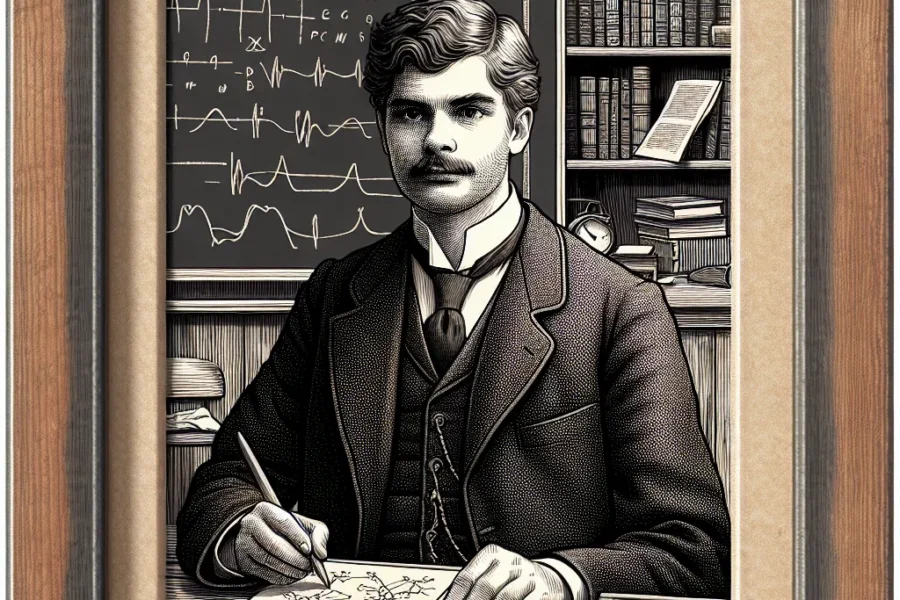Hermann Rorschach, the Swiss psychiatrist and psychoanalyst, left an indelible mark on the field of psychology with his ingenious contribution, the Rorschach inkblot test. Born on November 8, 1884, in Zurich, Switzerland, Rorschach came from an artistic family which significantly influenced his fascination with symbolism and perception – facets that later crystallized into his life’s work. Hermann’s early exposure to art, coupled with a strong academic prowess, set the stage for a revolutionary career that bridged the gap between visual art and the human psyche.
Rorschach’s intellectual quest began at the University of Zurich where he pursued his medical studies. It was here that he demonstrated a keen interest in the subject of psychoanalysis, which was burgeoning under the influence of luminaries such as Sigmund Freud and Carl Jung. Rorschach was particularly intrigued by the potential of exploring unconscious processes — a concept pivotal to his later contributions.
As he progressed through his academic journey, Hermann Rorschach delved deeper into the world of psychiatry, hosting a myriad of positions within various Swiss psychiatric institutions. His clinical experiences nurtured his curiosity about the mental workings of his patients. He began to observe the dynamics of personality through the interpretative actions and reactions of individuals when presented with ambiguous stimuli.
The year 1921 became a defining milestone in Rorschach’s career, for it was then that he formally introduced the Rorschach inkblot test. In his groundbreaking book, “Psychodiagnostik,” he documented the test, setting the foundation for its widespread adoption and integration into psychological assessment practices. The inkblot test comprised a series of 10 cards, each featuring a unique, symmetrical inkblot. The fundamental idea was that by interpreting the ambiguous forms, participants would project their unconscious thoughts, emotions, and experiences onto the inkblots, thus offering a window into their mental states.
The inception of the Rorschach test was met with both enthusiasm and skepticism. Some praised it for its innovative approach to parsing the layers of the human mind, while others questioned its reliability and validity. Nevertheless, Rorschach’s work progressively gained traction, earning a place in clinical settings as a tool for psychological evaluation, particularly in personality assessment and the diagnosis of mental disorders.
Hermann Rorschach’s professional life, although cut short by his untimely death at the age of 37 from peritonitis, had a profound and lasting influence. The Rorschach inkblot test not only survived him but evolved and became one of the most widely used projective tests in clinical psychology and psychiatry. Its utility extended beyond clinical diagnostics to fields such as forensic assessment, education, and organizational psychology.
Beyond the inkblot test, Rorschach was an astute clinician with a compassionate approach to his patients. His work integrated the psychodynamic concepts of the time with empirical research, emphasizing the importance of observational study and clinical experience. Hermann’s dual interest in art and science distinguished his methodology and ensured his legacy in the field of psychology.
The Rorschach inkblot test has undergone numerous modifications and interpretations since Hermann Rorschach first conceptualized it. Different scoring systems, such as the Exner system, have been developed to standardize interpretation and increase its psychometric properties. Moreover, research pertaining to the inkblot test has grown substantially. Scholars have published extensively on the test’s validity, reliability, and application across cultures and populations, ensuring its relevance in contemporary psychological assessment.
Despite its controversial aspects, Rorschach’s test has been a subject of continuous study. It has provided insights into cognitive processes, including perception, thinking, and problem-solving. Furthermore, it has acted as a catalyst in the examination of emotional disorders, inspiring a plethora of additional projective tests aimed at unmasking the complexities of the human mind.
The life and work of Hermann Rorschach encapsulate the interplay between creativity and scientific inquiry. His ability to harness the subjective nature of perception and channel it into a structured psychological tool remains a testament to his ingenuity and foresight. Rorschach stands as an exemplar in the history of psychology—his name synonymous with one of the most captivating and enigmatic psychological instruments.
Beyond the inkblots, Hermann Rorschach’s influence extends to contemporary debates about the nature of psychological assessment. Ongoing discourse regarding the merits of projective testing versus objective methods continues to draw upon the foundational aspects of Rorschach’s work. This reflects the enduring impact of his contributions and the persistent quest within psychology to understand the profound depths of human nature.
Rorschach’s professional achievements were met with various honors and commemorations, acknowledging the transcendental nature of his contributions. The Rorschach Society, established in his memory, serves to perpetuate his pioneering spirit by promoting the scholarly examination and ethical use of the inkblot test. Conferences and workshops dedicated to the Rorschach inkblot test provide platforms for continued education and research, fostering dialogue among mental health professionals worldwide.
Moreover, Hermann Rorschach’s life has been depicted in biographies and documentaries, highlighting his journey and celebrating his interdisciplinary approach. By blending art, psychology, and science, Rorschach’s legacy invites us to consider the boundless ways in which we can seek to understand the human psyche.
To appreciate the life and work of Hermann Rorschach is to acknowledge the complexity and beauty inherent in human psychology. His vision for tapping into the unspoken and unseen realms of thought and emotion set a precedent for future explorations in the field. As the Rorschach inkblot test continues to be utilized and studied, it serves as a reminder of the rich history it carries—a history crafted by a man who dared to look beyond the surface and into the blurred lines of psyches.
Hermann Rorschach’s life may have been brief, but the indelible ink he left on the canvas of psychology is as potent and mysterious as the patterns depicted in his famous test. The Rorschach test stands as a bridge between subjective experiences and objective analysis, a paradoxical blend mirroring the enigma of the human mind itself. Thus, the essence of Rorschach’s work resides not only in the inkblots but also in the continuous pursuit of understanding, interpreting, and appreciating the intricate workings of our inner worlds.
In conclusion, Hermann Rorschach’s life and work continue to resonate within the psychological community and beyond. His unique perspective and innovative methods for probing the human personality have stood the test of time, influencing subsequent generations of psychologists and psychoanalysts. While the Rorschach inkblot test remains a topic of debate, its contribution to the fields of psychology, art, and psychoanalysis cannot be understated. Hermann Rorschach’s legacy endures—an emblem of creativity, scientific inquiry, and the perpetual quest to decipher the mysteries of the human mind.



Leave a Comment